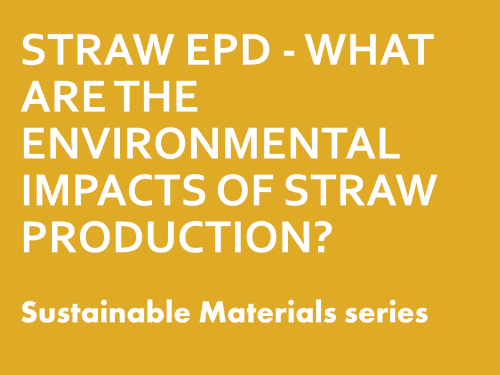Straw EPD - quantifying the environmental impacts of straw production
Originally posted 2nd March 2022
In October last year an Environmental Product Declaration (EPD) was published for Straw as Insulation Material in the UK. This was the culmination of months of research and discussions, funded and led by The School of Natural Building and the European Interreg-funded project Up Straw project.
Previously there was a lack of reliable data on the carbon and other environmental impacts of strawbale, with an oft-quoted figure used that ultimately traced back to a pamphlet from the USA in the 1970s based on hay and straw production, and derived from estimates of costs to farmers of straw production.
The new EPD provides an accurate assessment based on formal UK Government data (supplemented where necessary with data from EU Life Cycle Assessment databases) for UK grain and straw production. This covers the average fertiliser and pesticide inputs into UK wheat and barley production (per hectare planted and kg of crop produced), along with fuel use and grain/straw yield data.
The resulting impacts are then split between grain and straw according to economic value (price) of each. It’s important to remember that straw is not a waste product but a co-product. It has its own uses and own market. But as I explored in a previous blog, there is sufficient straw readily available in the UK to build tens of thousands of houses a year - without having a significant impact on other uses of straw.
The EPD assumes that at the end of the end of a building’s life 95 % of the straw will be incinerated (for energy recovery) and 5 % will be landfilled. Hopefully in reality much of the straw would be directly re-used in another building, but from a life cycle assessment perspective the carbon is still counted as released from the building in that case (because in the event of re-use any stored carbon is literally and physically transferred to the new building).
My involvement in the EPD process was ploughing through the pages of UK government statistical spreadsheets to extract and collate the necessary data to base the environmental impact assessments on. This was then used by NIBE to calculate the impacts and prepare the EPD. Finally, the EPD and the data used to prepare it was externally verified by Andrew Norton at Renuables before registration and publication on the International EPD Platform, Environdec.
You can download it and use the data here: https://www.environdec.com/library/epd3854
Environmental Product Declarations (EPDs) are formal declarations of the environmental impacts resulting from production, use, and disposal of a product. They follow strict standards of calculation methods and reporting, detailed in European standard EN15804. Before publication they are externally verified to ensure all calculations are correct and that the results are compliant with the standard. The latest version of the standard (EN15804+A2) requires more detailed reporting of carbon emissions than older versions, with biogenic carbon (in this case carbon absorbed by the straw as it grew), fossil fuel carbon emissions, and emissions resulting from land use change all reported separately.
The EPD reports a full range of environmental impact indicators but of most pressing importance are the carbon emissions:
Across the whole lifecycle (from production of strawbale to eventual disposal of straw once a building is demolished), the carbon emissions of 1 cubic metre of UK straw (at density of 100 kg/m³) are 14.12 kgCO₂e/m³.
A cubic metre of straw stores 129.25 kgCO2e (biogenic carbon), for as long as that straw remains part of a building.
The whole life carbon impact from land use and land use change is 0.02 kgCO₂e/m³
The data from the UK Straw EPD can be used to assess the whole life carbon impact of buildings using straw, in combination with EPD data for the other materials involved. The carbon data is now included in PHribbon and OneClick LCA.
In a future blog I’ll compare some of the other environmental impact indicators from the EPD with those for other products, but for now here are some carbon emissions comparisons.
The first chart below compares the whole life carbon (lifecycle stages A-C) emissions of straw to a selection of common insulation materials, given as the emissions resulting from 1 m² of material at sufficient thickness to achieve a U value of 0.14 W/m²K . The second chart compares the amount of carbon stored by the same (Lifecycle stages A1:A3 - stored carbon is released at end of life - this is release is accounted for in the first chart).
The next chart compares the whole life carbon emissions (based on a reference building life cycle of 60 years) resulting from 1 m² of four walls of similar structure: insulation placed between timber I-Beams, with wood fibre board and lime render externally, and plasterboard with gypsum plaster internally (this is used to provide a fair comparison between the insulation materials, not as a recommendation of building technique). The U value of all four walls is 0.15 W/m²K. ‘A’ on the chart refers to life cycle stage A – emissions up to completion of a building; ‘B-C’ refers to lifecycle stages B-C – use and ultimate disposal of a building. The final chart is the stored carbon (A1-A3) in the same structures.




